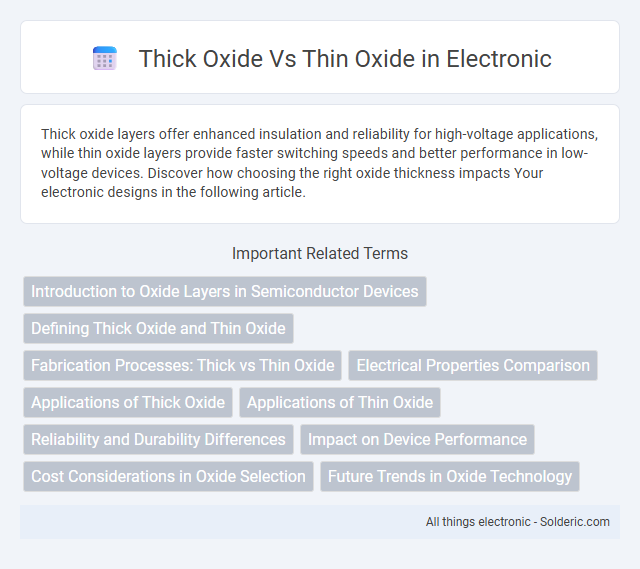Thick oxide layers offer enhanced insulation and reliability for high-voltage applications, while thin oxide layers provide faster switching speeds and better performance in low-voltage devices. Discover how choosing the right oxide thickness impacts Your electronic designs in the following article.
Comparison Table
| Feature | Thick Oxide | Thin Oxide |
|---|---|---|
| Oxide Thickness | Greater than 10 nm | Less than 5 nm |
| Leakage Current | Low leakage current | Higher leakage current |
| Gate Capacitance | Lower capacitance | Higher capacitance |
| Device Speed | Slower switching speed | Faster switching speed |
| Breakdown Voltage | Higher breakdown voltage | Lower breakdown voltage |
| Application | Power devices, analog circuits | High-speed digital circuits |
| Reliability | Higher reliability under high voltage stress | More susceptible to oxide breakdown |
Introduction to Oxide Layers in Semiconductor Devices
Oxide layers in semiconductor devices serve as crucial insulating barriers, impacting device performance and reliability. Thick oxide layers offer enhanced insulation and higher breakdown voltage, making them ideal for power devices and isolation regions, while thin oxide layers enable faster switching speeds and increased capacitance, essential for advanced MOSFETs and high-density integrated circuits. Precise control over oxide thickness during fabrication is fundamental to optimizing device characteristics such as threshold voltage, leakage current, and overall electrical behavior.
Defining Thick Oxide and Thin Oxide
Thick oxide refers to a silicon dioxide layer typically greater than 100 nanometers, used in applications requiring enhanced insulation and reduced leakage currents. Thin oxide layers, usually less than 10 nanometers, are essential in advanced semiconductor devices for gate dielectrics, enabling high electron mobility and precise control of electrical characteristics. The thickness difference crucially impacts device performance, reliability, and scaling in integrated circuits.
Fabrication Processes: Thick vs Thin Oxide
Thick oxide layers are typically formed through prolonged thermal oxidation at higher temperatures, resulting in a robust and uniform dielectric suitable for isolation and protective applications. Thin oxide layers require controlled low-temperature oxidation or advanced deposition techniques like atomic layer deposition (ALD) to achieve precise thickness control crucial for gate dielectrics in MOSFETs. Fabrication of thick oxides prioritizes defect minimization and stress management, whereas thin oxide processes emphasize ultra-clean environments and atomic-scale uniformity to ensure device performance and reliability.
Electrical Properties Comparison
Thick oxide layers exhibit higher breakdown voltage and lower leakage current compared to thin oxide layers, making them suitable for high-voltage applications. Thin oxide layers offer superior switching speed and higher gate capacitance, enhancing transistor performance in low-voltage, high-frequency circuits. Your choice between thick and thin oxide depends on the required balance between electrical insulation and device speed.
Applications of Thick Oxide
Thick oxide layers are primarily used in power devices and high-voltage applications due to their superior dielectric strength and ability to tolerate higher electric fields without breakdown. These layers provide effective insulation in MOSFETs, IGBTs, and other semiconductor components, enhancing device reliability at elevated voltages. Thick oxide is also critical in isolation technologies within integrated circuits, preventing parasitic conduction and cross-talk between adjacent devices.
Applications of Thin Oxide
Thin oxide layers are extensively used in semiconductor devices to form gate oxides in MOSFETs, enabling enhanced electron mobility and improved transistor switching speeds essential for modern integrated circuits. Their precise thickness control is critical for non-volatile memory applications like EEPROM and flash memory, ensuring reliable charge storage and data retention. Your advanced electronics benefit from thin oxide's role in achieving miniaturization and high-performance characteristics in microprocessors and sensors.
Reliability and Durability Differences
Thick oxide layers offer superior reliability and durability due to their enhanced resistance to leakage currents and improved tolerance to high voltage stress, making them ideal for long-term applications. Thin oxide layers, while enabling faster switching speeds and better performance in low-voltage environments, are more susceptible to breakdown and degradation over time. Your choice between thick and thin oxide should consider the specific demands of your device's operational environment to maximize lifespan and maintain consistent performance.
Impact on Device Performance
Thick oxide layers offer enhanced device reliability and higher breakdown voltage, making them suitable for power applications, while thin oxide layers enable faster switching speeds and greater transistor density due to reduced gate capacitance. Your choice between thick oxide and thin oxide directly impacts leakage current levels and overall device efficiency, with thin oxides generally increasing leakage but improving performance in high-speed circuits. Device performance optimization requires balancing these trade-offs based on application-specific requirements such as speed, power consumption, and longevity.
Cost Considerations in Oxide Selection
Thick oxide layers typically incur higher material and fabrication costs due to increased deposition time and resources, whereas thin oxide processes are generally more cost-effective for high-volume manufacturing. Thin oxide also enables finer device scaling and lower power consumption, contributing to overall cost savings in advanced semiconductor applications. Choosing between thick and thin oxide requires balancing performance requirements with budget constraints, as thick oxide offers better reliability in high-voltage conditions at the expense of increased manufacturing expenses.
Future Trends in Oxide Technology
Future trends in oxide technology highlight the shift towards ultra-thin oxide layers to enhance transistor performance and reduce power consumption in advanced semiconductor devices. Innovations in high-k dielectric materials are driving improvements in gate control and reliability over traditional thick oxides. Your ability to leverage these advancements will be crucial for developing next-generation integrated circuits with superior speed and energy efficiency.
Thick Oxide vs Thin Oxide Infographic

 solderic.com
solderic.com